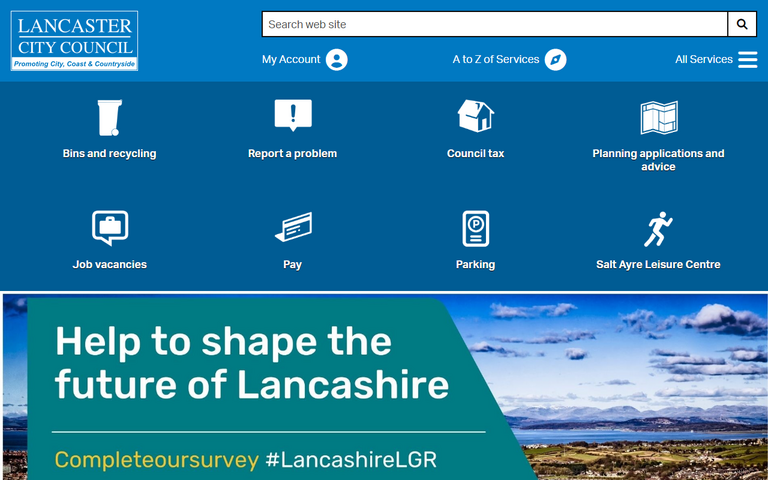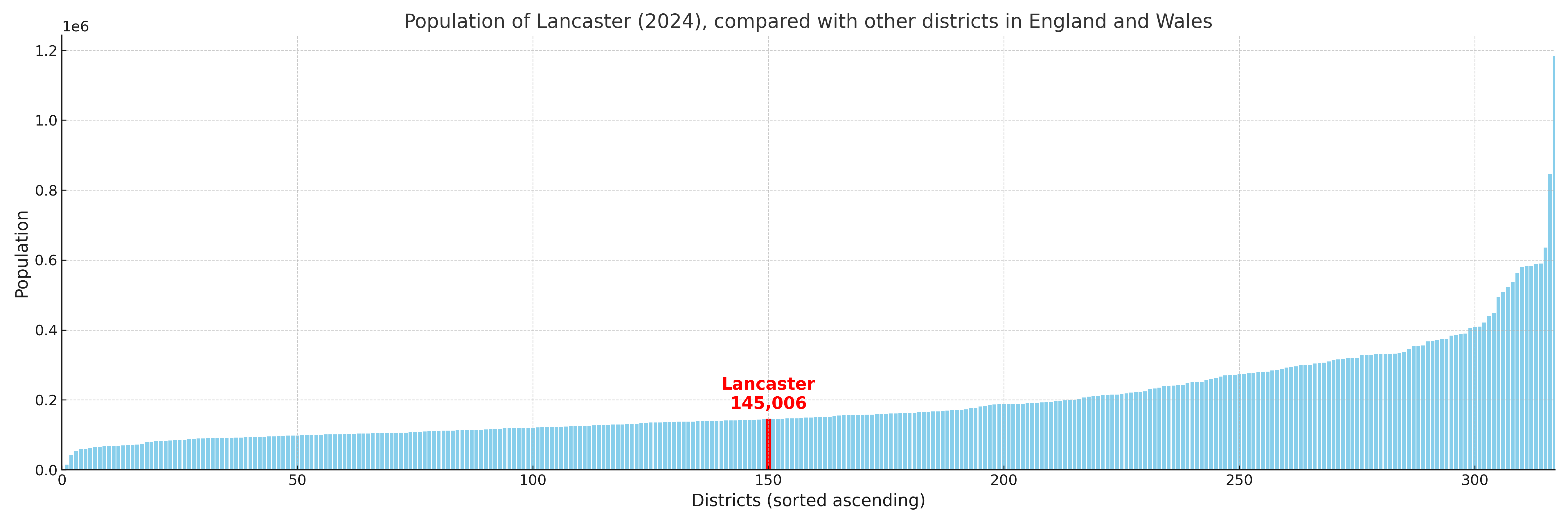Lancaster
§ This page gives an overview of the Lancaster local authority district, bringing together key facts, maps, and data to help you quickly understand the area. One of 361 district profiles on Baseview.
Overview ⁞ Lancaster sits on the River Lune in north Lancashire, with a historic city dominated by Lancaster Castle, Georgian architecture, and a lively cultural scene. The district stretches to the coast, including Morecambe Bay with its seafront and views to the Lake District, and inland to the Forest of Bowland Area of Outstanding Natural Beauty. Villages like Carnforth and Silverdale add charm, with nature reserves, limestone hills, and estuaries shaping the landscape. Lancaster blends coast, countryside, and heritage in equal measure.
Lancaster Boundary Map
This map shows the official boundary of the Lancaster local authority district, based on the latest geographic data published by the Office for National Statistics (ONS). It provides a clear view of the district’s extent and helps you understand how the area fits within the wider regional and national landscape.
Contains OS data © Crown copyright and database right 2025. Source: Office for National Statistics licensed under the Open Government Licence v3.0.
The administrative boundary of Lancaster can also be viewed on OpenStreetMap: District Boundary of Lancaster.
Key Facts about Lancaster
What region is Lancaster in? Lancaster is in the North West of England, a region within the UK.
What county is Lancaster in? Lancaster is located in the county of Lancashire.
Is Lancaster a city? Yes, Lancaster is a city. Lancaster holds official city status as one of the 76 designated cities in the UK.
Who governs Lancaster? The local authority for this district is: Lancaster City Council - responsible for district-level services. Since Lancashire is a two-tier area, county-level services are handled by: Lancashire County Council.
▶ Official website of Lancaster City Council 🔗 lancaster.gov.uk

Which police force covers Lancaster? Policing in Lancaster is provided by Lancashire Constabulary 🔗 lancashire.police.uk, which serves 14 local authority districts: Blackburn with Darwen ⁞ Blackpool ⁞ Burnley ⁞ Chorley ⁞ Fylde ⁞ Hyndburn ⁞ Lancaster ⁞ Pendle ⁞ Preston ⁞ Ribble Valley ⁞ Rossendale ⁞ South Ribble ⁞ West Lancashire ⁞ Wyre.
Lancaster in International Geographies
In the International Territorial Levels (ITLs) hierarchy, Lancaster is within an ITLs Level 3 area:
- (ITL 1) North West
- (ITL 2) ⇒ Lancashire
- (ITL 3) ⇒⇒ Lancaster and Wyre
The International Territorial Levels are used by OECD member countries for statistical purposes to classify administrative areas. We have this listable page for easy browsing of ITL names and codes: International Territorial Levels.
Constituencies in Lancaster
Lancaster is divided into 2 parliamentary constituencies, listed below in alphabetical order.
A constituency is a specific geographical area that elects one Member of Parliament (MP) to represent them in the House of Commons. The United Kingdom is divided into 650 parliamentary constituencies. We have this list page for easy browsing of all UK parliamentary constituencies: List of Constituencies.
Wards in Lancaster
Lancaster is divided into 27 wards, listed below in alphabetical order.
- Bare
- Bolton & Slyne
- Bowerham
- Bulk
- Carnforth & Millhead
- Castle
- Ellel
- Halton-with-Aughton & Kellet
- Heysham Central
- Heysham North
- Heysham South
- John O'Gaunt
- Lower Lune Valley
- Marsh
- Overton
- Poulton
- Scale Hall
- Scotforth East
- Scotforth West
- Silverdale
- Skerton
- Torrisholme
- University
- Upper Lune Valley
- Warton
- West End
- Westgate
In the UK, a ward is a subdivision of a local authority area, used mainly for electoral and statistical purposes. Defined by the ONS, wards represent the primary unit for local elections, each returning one or more councillors to the local council. Wards are also used as a key geography for presenting population and census data.
Parishes in Lancaster
Lancaster is part-parished: 38 civil parishes (listed A-Z below) alongside 2 unparished areas.
- Aldcliffe-with-Stodday
- Arkholme-with-Cawood
- Bolton-le-Sands
- Borwick
- Burrow-with-Burrow
- Cantsfield
- Carnforth
- Caton-with-Littledale
- Claughton
- Cockerham
- Ellel
- Gressingham
- Halton-with-Aughton
- Heaton-with-Oxcliffe
- Hornby-with-Farleton
- Ireby
- Leck
- Melling-with-Wrayton
- Middleton
- Morecambe
- Nether Kellet
- Over Kellet
- Over Wyresdale
- Overton
- Priest Hutton
- Quernmore
- Roeburndale
- Scotforth
- Silverdale
- Slyne-with-Hest
- Tatham
- The Yealands
- Thurnham
- Tunstall
- Warton
- Wennington
- Whittington
- Wray-with-Botton
A civil parish is the lowest tier of local government in England, used for villages, small towns, and suburbs. They have their own local authority, either a parish council or a parish meeting, which provides local services like managing parks, allotments, and streetlights, and represents the community's views to larger councils.
Built-up Areas in Lancaster
Lancaster covers 18 built-up areas, listed below in alphabetical order.
- Bailrigg
- Bolton-le-Sands
- Carnforth
- Caton
- Galgate
- Halton (Lancaster)
- Heysham
- Hornby
- Lancaster
- Middleton (Lancaster)
- Morecambe
- Nether Kellet
- Over Kellet
- Overton (Lancaster)
- Silverdale *
- Stodday
- Tewitfield
- Warton (Lancaster)
In the UK, a Built-up Area (BUA) is a continuous urban area of at least 20 hectares (0.2 km²), defined by the ONS as land where buildings are generally no more than 200 metres apart, such as towns, cities, or large villages. (Note: A BUA name marked with an asterisk (*) indicates that the area is situated partly in the district of Lancaster.)
Lancaster compared with other districts in the UK
This section shows how Lancaster compares with other local authority districts in the UK, using a variety of measures and rankings.
Lancaster has 27 electoral wards.

Lancaster has a population of 145,006 (2024 mid-year estimate by ONS)

More local statistics and data for Lancaster can be found on the ONS statistics for Lancaster.